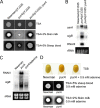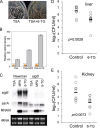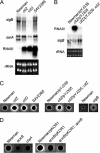Golden pigment production and virulence gene expression are affected by metabolisms in Staphylococcus aureus
- PMID: 20400547
- PMCID: PMC2901709
- DOI: 10.1128/JB.00928-09
Golden pigment production and virulence gene expression are affected by metabolisms in Staphylococcus aureus
Abstract
The pathogenesis of staphylococcal infections is multifactorial. Golden pigment is an eponymous feature of the human pathogen Staphylococcus aureus that shields the microbe from oxidation-based clearance, an innate host immune response to infection. Here, we screened a collection of S. aureus transposon mutants for pigment production variants. A total of 15 previously unidentified genes were discovered. Notably, disrupting metabolic pathways such as the tricarboxylic acid cycle, purine biosynthesis, and oxidative phosphorylation yields mutants with enhanced pigmentation. The dramatic effect on pigment production seems to correlate with altered expression of virulence determinants. Microarray analysis further indicates that purine biosynthesis impacts the expression of approximately 400 genes involved in a broad spectrum of functions including virulence. The purine biosynthesis mutant and oxidative phosphorylation mutant strains exhibit significantly attenuated virulence in a murine abscess model of infection. Inhibition of purine biosynthesis with a known small-molecule inhibitor results in altered virulence gene expression and virulence attenuation during infection. Taken together, these results suggest an intimate link between metabolic processes and virulence gene expression in S. aureus. This study also establishes the importance of purine biosynthesis and oxidative phosphorylation for in vivo survival.
Figures







Similar articles
-
The purine biosynthesis regulator PurR moonlights as a virulence regulator in Staphylococcus aureus.Proc Natl Acad Sci U S A. 2019 Jul 2;116(27):13563-13572. doi: 10.1073/pnas.1904280116. Epub 2019 Jun 19. Proc Natl Acad Sci U S A. 2019. PMID: 31217288 Free PMC article.
-
De Novo Purine Biosynthesis Is Required for Intracellular Growth of Staphylococcus aureus and for the Hypervirulence Phenotype of a purR Mutant.Infect Immun. 2020 Apr 20;88(5):e00104-20. doi: 10.1128/IAI.00104-20. Print 2020 Apr 20. Infect Immun. 2020. PMID: 32094249 Free PMC article.
-
Staphylococcus aureus golden pigment impairs neutrophil killing and promotes virulence through its antioxidant activity.J Exp Med. 2005 Jul 18;202(2):209-15. doi: 10.1084/jem.20050846. Epub 2005 Jul 11. J Exp Med. 2005. PMID: 16009720 Free PMC article.
-
Metabolic control of virulence factor production in Staphylococcus aureus.Curr Opin Microbiol. 2020 Jun;55:81-87. doi: 10.1016/j.mib.2020.03.004. Epub 2020 May 7. Curr Opin Microbiol. 2020. PMID: 32388086 Free PMC article. Review.
-
Virulence regulation in Staphylococcus aureus: the need for in vivo analysis of virulence factor regulation.FEMS Immunol Med Microbiol. 2004 Oct 1;42(2):147-54. doi: 10.1016/j.femsim.2004.05.005. FEMS Immunol Med Microbiol. 2004. PMID: 15364098 Review.
Cited by
-
Comparative transcriptome analysis of microsclerotia development in Nomuraea rileyi.BMC Genomics. 2013 Jun 19;14:411. doi: 10.1186/1471-2164-14-411. BMC Genomics. 2013. PMID: 23777366 Free PMC article.
-
Significance of four methionine sulfoxide reductases in Staphylococcus aureus.PLoS One. 2015 Feb 13;10(2):e0117594. doi: 10.1371/journal.pone.0117594. eCollection 2015. PLoS One. 2015. PMID: 25680075 Free PMC article.
-
Coagulase-negative staphylococci release a purine analog that inhibits Staphylococcus aureus virulence.Nat Commun. 2021 Mar 25;12(1):1887. doi: 10.1038/s41467-021-22175-3. Nat Commun. 2021. PMID: 33767207 Free PMC article.
-
Drug-Resistant Staphylococcus aureus Strains Reveal Distinct Biochemical Features with Raman Microspectroscopy.ACS Infect Dis. 2018 Aug 10;4(8):1197-1210. doi: 10.1021/acsinfecdis.8b00029. Epub 2018 Jun 25. ACS Infect Dis. 2018. PMID: 29845863 Free PMC article.
-
Small-molecule targeting of a diapophytoene desaturase inhibits S. aureus virulence.Nat Chem Biol. 2016 Mar;12(3):174-9. doi: 10.1038/nchembio.2003. Epub 2016 Jan 18. Nat Chem Biol. 2016. PMID: 26780405
References
-
- Bae, T., and O. Schneewind. 2006. Allelic replacement in Staphylococcus aureus with inducible counter-selection. Plasmid 55:58-63. - PubMed
-
- Bronner, S., H. Monteil, and G. Prevost. 2004. Regulation of virulence determinants in Staphylococcus aureus: complexity and applications. FEMS Microbiol. Rev. 28:183-200. - PubMed
Publication types
MeSH terms
Substances
Grants and funding
LinkOut - more resources
Full Text Sources
Other Literature Sources

